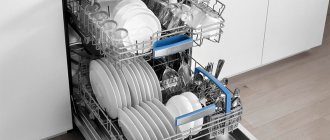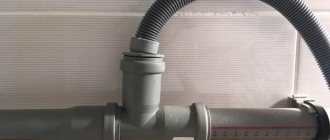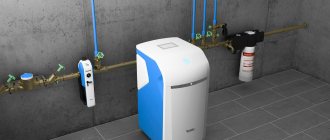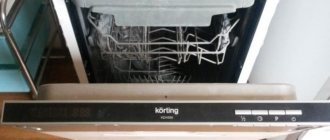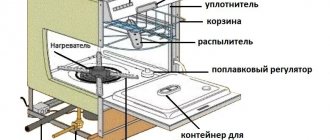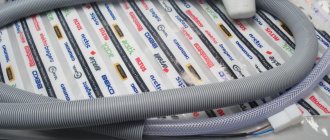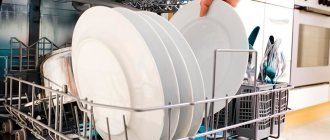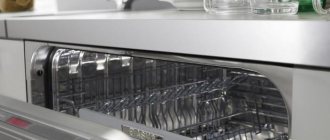Pros of dishwasher tablets
Tablets for PMM have a number of advantages when compared with other products. This includes the following points:
- Wide selection of funds. Thanks to this, it is possible to select a drug with the desired composition;
- Optimal consumption;
- You can find dishwasher detergent in almost any store;
- To add the product, there is no need to measure it using a measuring spoon;
- Most tablets have a permanent coating. There is no need to unpack them before use - they go straight into the dishwasher;
- Capsules are the easiest to store. Unlike gel, they cannot crumble or spill;
- During its action, the tablet product does not create a lot of foam, which has a positive effect on the operation of the dishwasher;
- The products in tablets have a safe composition, so they cannot cause an allergic reaction or harm human health;
- Despite their hard structure, the tablets do not leave scratches on dishes. In addition, they protect the dishwasher from plaque and corrosion;
- Additional substances contained in the tablets give the dishes a light and fresh aroma.
What can't be washed in the dishwasher?
What can't be washed in the dishwasher?
Tree
If a tree is placed in water for a long time, it will expectedly swell and increase in size. Those. wooden spoons, rolling pins, etc. utensils will become unusable. After drying, the bond between the fibers will be destroyed, and such dishes will still remain with defects: a different shape, cracks, roughness.
Even if you are not going to put wooden dishes in the dishwasher for a long time, the effect will be the same due to boiling water and detergents.
Plastic
You can use the dishwasher and load plastic dishes, as long as they are heat-resistant. Look for the icon that allows the machine to wash.
We do not recommend loading into the lower basket, because... the heating element is closest to it, the products may melt. You cannot wash disposable tableware!
If you have dishes that can maintain a vacuum inside, then they also cannot be washed in a machine. Otherwise, the plastic will deform and the container will lose its seal; in other words, air will begin to enter it.
Principle of operation
Due to the fact that tablets from different manufacturers differ in their composition, they can have different effects on dishes. Despite this, all drugs have a number of common functions. If we talk about the composition, then the combined tablets contain not only detergent, but also salt and rinse aid.
In addition, the composition may include such components as:
- Substances for protecting metal parts of the dishwasher from rust;
- Substances for protecting silverware from tarnishing;
- Antibacterial components;
- Bleaching agents;
- Flavorings, etc.
After the washing program is started, a capsule will fall out of the compartment and begin to slowly disintegrate. First, the layer containing the detergent and salt dissolves. At the very end, another, final layer dissolves (in Finish brand capsules it is a red ball).
Sometimes it happens that the tablet may fall out of the compartment only at the end of the wash. Most often this happens because the dishes were placed incorrectly.
When you can solve the problem yourself
There are many reasons why your dishwasher won't flush out a tablet or powder. It often happens that the PMM took the product from the compartment, but it did not completely dissolve during the wash cycle, and you see the remains of a tablet or powder inside the dishwasher. If this happened for the first time, there is no need to panic. To begin with, exclude the following situations related to the operating rules of the PMM.
- Wet compartment for detergents . If you see moisture in the product dispenser, you must first wipe the compartment with a paper napkin, and only then put in a tablet or pour in powder. Otherwise, the products may stick to the compartment and will not be washed away by the water pressure.
- Selecting a program without detergents . Make sure you select the correct wash program. If “rinse dishes” was selected, no detergent will be collected. On short programs, some of the funds may also remain in the dispenser.
- Filters clogged . The water circulating when washing dishes is cleaned many times during the cycle through a filter system. If they are dirty, the water pressure from the sprinklers decreases: as a result, the machine does not wash away or does not completely wash out the tablet, powder and rinse aid. To avoid this problem, do not forget to clean the filters as they become dirty: from once to several times a week, depending on how actively you use the PMM.
- Locking the lid of the compartment with dishwashing detergents . If the dishes are placed incorrectly, they may block the dispenser lid. As a result, the tablet compartment in the dishwasher does not open, the machine does not eject the tablet, and the wash proceeds without any detergent. To avoid such a situation, always place dishes in accordance with the recommendations from the instructions for your PMM, do not overload it.
- Locking the detergent compartment lid with a tablet . In most PMMs, the tablet must be placed horizontally in the compartment. Vertical or edge-on placement leads to the fact that the lid clings to the tablet and physically cannot open, as a result, the tablet does not fall out. How to properly place the tablet in your dishwasher model is described in the instruction manual.
- Incorrect use of tablets . Some tablets have water-soluble packaging, while others require the protective film to be removed. If the packaging needed to be removed, but you did not, the tablet will not dissolve and will remain intact.
Location of the tablet compartment
In order to put the capsules where they should be, you first need to take the time to read the instructions for using your dishwasher. If the instructions do not say anything about this, then you need to carefully inspect the device. Typically, the detergent compartment is located on the inside of the dishwasher door.
Pill and powder compartment: on the left in the image
Some dishwashers are equipped with several compartments for detergents. There is almost always a round compartment, closed with a lid with a flower - rinse aid is poured into it. To the left of it there is usually a rectangular compartment - powder or tablets are immersed in it.
Some dishwashers do not use combination tablets at all. However, you can put regular tablets in them; there is a special compartment next to the basket for this purpose. It is worth noting that if regular tablets are used, then there must also be salt in the dishwasher.
Where is the pill compartment?
In order not to be mistaken about where the tablet compartment is located and where to put it in a particular dishwasher model, do not be lazy, read the instructions first. If there is no such information, then carefully inspect the inside of the dishwasher. In most dishwasher models, the detergent compartments are located on the inside of the door. One of these compartments (marked F in Figure 1) is screwed on with a lid C, on which a flower can be drawn; this compartment is intended for rinse aid. Some machines may have a rinse aid indicator light D next to the rinse aid.
Compartment 2 is the main compartment intended for detergents; this is the compartment where powder is poured or gel is poured, or a tablet is placed. Compartment 3 is intended for a small amount of detergent, about 5 g of powder or gel, for the preliminary wash cycle.
In some machine models, for example, in Bosch dishwashers, the compartments are located differently. Figure 2. In this figure, number 1 indicates a compartment for powder or gel, number 2 indicates a compartment for rinse aid, and number 3 indicates a compartment for tablets.
There are dishwashers in which you cannot use combined tablets (3 in 1, 5 in 1 or others) at all.
But it is possible to use simple tablets; for this purpose, a small container for tablets is provided on the upper basket as in the photo below. When using ordinary tablets or with very hard water, you must definitely use salt , and we described how much and where to pour it in one of our articles.
To open or not to open the package
Before using dishwasher tablets, you need to read the instructions for use indicated on the box with such tablets. There are many types and brands of tablets, so they may differ from each other. It is very important. Each tablet is wrapped in packaging, which can be soluble or insoluble. If the packaging is not soluble, then the tablet will not dissolve, so the packaging must be opened before use.
For your information! Instant packages are usually transparent and do not have cuts or strips for opening. Tablets wrapped in foil definitely need to be opened.
Here is an example of tablets with dissolving packaging:
- Finish Quantum;
- Sun All in one;
- Sodasan;
- Dish Drops;
- Amway.
Tablets whose wrapper does not dissolve:
How the tablet works
Dishwasher tablets may differ in their composition, and therefore they will have different effects. However, they all have the same basic functions. Most combination tablets contain detergent, salt and rinse aid. Additional components that may or may not be included include:
- substances that protect metal from corrosion;
- substances that protect silver tableware from tarnishing;
- antibacterial and disinfectant components;
- bleaching agents;
- defoamers;
- flavorings, etc.
Do I need to open the package?
Before using this product, you should carefully read the instructions on the packaging of the product. There is a wide variety of tablets, and each drug has its own characteristics. In addition, tablets come in soluble and insoluble packaging. In the second case, before throwing the product into the dishwasher, you will need to rid it of insoluble packaging.
It is worth noting that completely soluble capsules are usually packaged in thin material, the surface of which does not have stripes for opening. If the tablet is in foil or polyethylene, then it must be opened before use.
Nuances
The use of dishwasher capsules, like the use of other detergents, has its own nuances. First of all, all people who have never used tablets before are interested in the question: “how much product is needed for one wash?” Experienced users said that one tablet is enough for one wash with a full load. If the dishwasher is only half full of dishes, then half a tablet is enough. Also, half of it is enough for one wash in a small dishwasher (with a full load).
It is also important to choose the right washing mode. Typically, the instructions for modern dishwashers indicate the mode that is most suitable for washing using tablets. Such modes differ in their duration and can last more than an hour. It is worth noting that tablets cannot be used when rinsing or soaking dishes.
It is important to store the detergent correctly. For storage you need to find a dry place out of reach of children. If the tablets have a soluble shell, then it is important that they are not exposed to moisture, as this will lead to the drug sticking together.
How to use dishwashing tablets
Dishwasher safe tablets should be stored in a dry place out of the reach of children. If the tablets are stored too long or incorrectly, they may become damp and lose their cleaning properties. In this case, first place one or half of the capsule in a glass of water. If they have not dissolved, the tablets cannot be used.
Before using the drug, be sure to read the instructions and follow the recommendations. Many products indicate which machines they are suitable for and at what minimum temperature they begin to dissolve. For very hard water, it is recommended to additionally use dishwasher salt. First, load the machine and place the dishes inside.
Then remove the packaging if the shell is removable, otherwise the tablets will not dissolve. Water-soluble capsules are placed without unpacking. As a rule, the latter have transparent packaging. Insoluble tablets have a bright or foil film that can be immediately noticed and needs to be removed. Then figure out where to put the tablet in the dishwasher.
What to do if the tablet falls out?
The answer to this question is as simple as possible - nothing. As the dishwasher operates, the tablet should fall out of the detergent compartment on its own and begin to dissolve slowly, layer by layer.
Some housewives, wanting to speed up the process of washing dishes, grind the tablets to a powder state. In the case of “3 in 1” tablets, this is strictly forbidden, since the product must come into play at the end of the washing process. If the product is crushed, then everything will be the opposite.
At the right moment, the product falls from the compartment and begins to gradually dissolve. It is important that the capsule leaves at the right time.
If this does not happen, then you need to look for the reason in the following:
- Incorrectly placed dishes, due to which the compartment lid cannot open normally;
- The dispenser is working properly.
The nuances of using tablets
Before starting to use a dishwasher, many people are interested in questions: which product is better to purchase, what is better - gel or tablets, how much product is required when the machine is fully loaded, and so on. To find answers to these questions, you need to know some of the nuances of using tablets.
During operation, many housewives have found that to partially load the dishwasher, it is enough to place half a tablet in a container in the dishwasher. The same option is suitable for a compact dishwasher.
Expert opinion
Vyacheslav Budaev
Dishwasher expert, repairman
Another important point in using capsules is the choice of washing mode. For example, the instructions for some modern machine models indicate in what washing mode it is necessary to use a 3 in 1 tablet. As a rule, these are long-term washing functions of more than one hour.
If there are small children at home, storage rules must be followed. The bright packaging and appearance of the capsules attract their attention. The chemical composition of the tablet can greatly harm the baby’s health if he tries to eat it. If the tablets have soluble packaging, then if moisture gets on it they can stick together, so they should be stored in a dry place.
1 tablet = 1 load - is this true?
In 1 cube, ingredients are prepared in a certain concentration for a single load of a full-size dishwasher. This is enough for about 12 sets of dishes.
Expert opinion
Vyacheslav Budaev
Dishwasher expert, repairman
However, it is uneconomical to use a whole tablet if there are few dirty utensils or the machine is small. It is very convenient to divide the cube into 2 parts and put in only half.
Eco-friendly products and hard water require salt and rinse aid.
Phosphates soften water and break down lime. They are absent in bio-tablets, which is why the washed dishes do not shine or are covered with a slight coating. To prevent this, add dishwashing salt and rinse aid while setting the water hardness setting to minimum.
Expert opinion
Vyacheslav Budaev
Dishwasher expert, repairman
Not only eco-products, but also all other tablets can give poor-quality results - for example, due to increased water hardness (over 26°e (21°dH)). Therefore, if after washing the cleanliness and shine of the dishes is not ideal, experiment with adding salt and rinse aid, even if they are among the ingredients.


